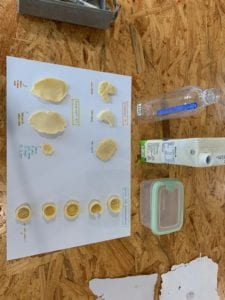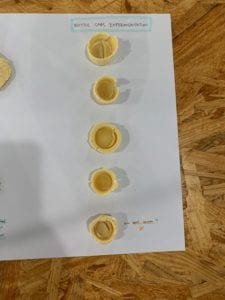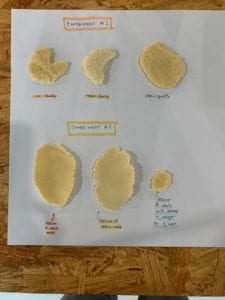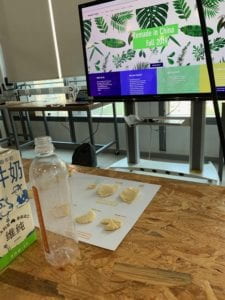Presentation Feedback:




During the presentation, I went through my various experiments, findings and final thoughts. Points such as how much was my overall cost, would the milk casein affect flavour of the drink and sustainability of these bottle caps were brought up.
Professor Marcela’s feedback rings true that in order to create a more sustainable product, there needs to also be a balance between the price point and how many times a product is going to be used. Although these bottle caps were functional, there is still a problem that milk is expensive and having to create one bottle cap that is only going to be used once then disposed of, would be too expensive.
In the future, I would try to focus more on this fact of realistically considering pricing and duration of usability than on the idea of trying to solve disposable products. In an ideal world, we would be able to use whichever resources we have to make our items more biodegradable, however in reality, there is always some sort of cost that would overrule the importance it being biodegradable.
Nonetheless, I’m still proud of my work and experimentation as I not only learned how to make bioplastics but I learned a valuable lesson in that finding alternatives for plastic is far from easy. It’s extremely easy to criticise and demand the use of biodegradable alternatives. However, this problem is so much more complex as it requires the product to not only be biodegradable but also cheap and easily massed produced — far from an easy task.
Final Thoughts/Conclusion:
Overall, from my experiments, I can conclude that milk can be used as bottle caps. I can see these being implemented in Shanghai and other places as it is easily mouldable and in an industrial setting could definitely be formed into very nice bottle caps that function just as well as our current ones. As such, this could be a more biodegradable product than the current plastic ones that are not able to be recycled and become plastic waste as milk casein is an all-natural product.
Through milk casein bottle caps, this will hopefully be able to raise awareness on the complexity of recycling. This was something that I learned a lot from this semester because of this class and I think is very important for everyone to know as well. I’m sure that not a lot of people are aware of how recycling works and furthermore, not aware that a lot of products are made with different types of plastics that can’t all be recycled. Through seeing these bottle caps, consumers become more aware of this fact and be more conscious of the way they consume and throw away trash as it is more complicated than just throwing trash in the right bin classification.
However, there are still problems such as how milk casein is not vegan and still harmful for the planet through still having to take care of cows and other mammalian livestock — contributing to tonnes of greenhouse gases and loss of land. Also, there is a problem that milk is expensive and in order to obtain casein, a large amount of milk has to be used and hence, sustainability is called into question. These milk bottle caps would possibly be more useful in countries where they have a lot of open land and hence, a lot of cows and milk such as Mongolia. Some countries have a surplus of milk which allows them to obtain milk easier and at a cheap price, allowing them to also make more milk casein plastic. Moreover, even in other places where milk is expensive, these milk bottle caps can still be made as a statement to still educate people on the complexity of recycling. These bottle caps don’t have to be made on a big scale and replace bottle caps but perhaps just for an educational display that is able to attract people and get them to know more about plastic recycling.
If I had more time, I would do further experiments on how to make the mould of the milk less fragile and breakable through experimenting on when to remove the casein from the mould. I would’ve also liked to try to make an actual bottle cap mould and see the difference with using that vs. just moulding the casein onto the bottle. This might also strengthen the end result. Finally, I chose to not explore soy milk as many sources online stated that plant-based milks wouldn’t work but as seen from the experiment of Cassie, this was proven to not be true. Given more time, I would hope for a plant-based milk bottle caps that would work as well as plastic bottle caps.
Thank you!
I would just like to thank Professor Marcela once again! With every class I attended throughout this semester, whether it be a lecture, guest talks or readings, I always learned something new about plastic, trash and the way we consume. I now see trash in a very different light than I did previously and I’m a lot more conscious about the complications and problems of the trash that we make and the ongoing search to find alternatives. I hope to see this class continuing to be taught as it sheds light on very serious and very real problems that our generation is facing and will face.
Leave a Reply